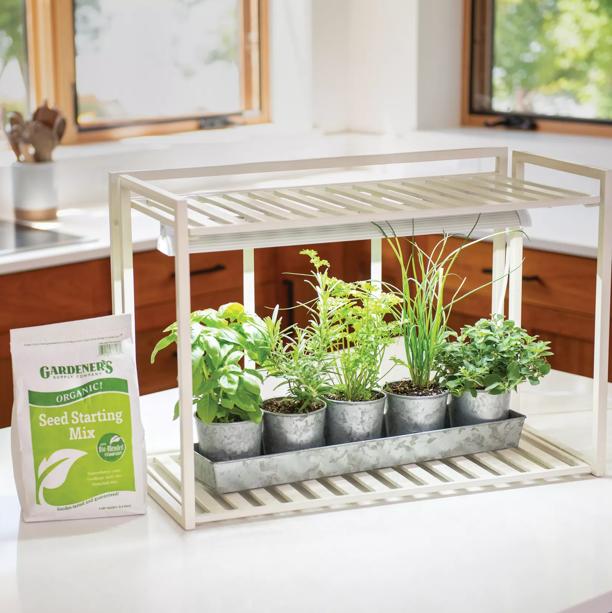How to Grow Herbs Indoors
Keep your kitchen stocked with fresh herbs grown right on your countertop!
 By planting herbs in separate pots, you can manage the watering needs of each. Many Mediterranean herbs — thyme, rosemary, and oregano, for example — benefit from free-draining soil and judicious watering, while basil likes soil that remains consistently moist.
By planting herbs in separate pots, you can manage the watering needs of each. Many Mediterranean herbs — thyme, rosemary, and oregano, for example — benefit from free-draining soil and judicious watering, while basil likes soil that remains consistently moist.Keep your kitchen stocked with fresh herbs all year! Whether you garden in chilly zone 3; whether you are short on indoor space; whether you have never gardened a day in your life — everyone can grow herbs indoors.

 If you don't have a sunny windowsill, most herbs will thrive under a grow light. Shown here: Oslo Tabletop Grow Kit (top) and Bamboo Mini LED Grow Light Garden (bottom).
If you don't have a sunny windowsill, most herbs will thrive under a grow light. Shown here: Oslo Tabletop Grow Kit (top) and Bamboo Mini LED Grow Light Garden (bottom).What do I need to grow herbs indoors?
- Potting soil: Many herbs, especially those native to the Mediterranean climate, must have loose, fast-draining soil. Soggy soil, especially in cooler winter temperatures, can be fatal to these plants. Plant rosemary, thyme, oregano, and bay laurel in a blend of equal parts of cactus mix and regular potting soil. Other herbs, like basil and mint, grow well in regular potting soil. Fertilize once or twice a month with a liquid houseplant fertilizer.
- Container: Starting seeds? Or transplanting a newly purchased rosemary plant? Either way, you'll need to select a container with a drainage hole in the bottom. This is really the only "must have" — no herb likes to grow in consistently soggy soil.
- Light: Herbs love light! Not enough window light from your south-facing window? Full-spectrum grow lights are ideal for all herbs. Place plants within 12 inches of the bulbs or follow the instructions provided with your lights. Start by having the lights on for 12 to 16 hours a day for bright-light plants and adjust as necessary.
How to Grow Herbs Indoors
From transplants
No time to wait for seeds to germinate? Stop by your garden center or even grocery store (by the produce section!) and purchase a small potted herb. Perennial herbs, such as rosemary, oregano, thyme, sage, and bay laurel are easiest to grow from young plants. Many potted herbs are rootbound after being stuffed in a store pot for so long — carefully remove them from the store pot and plant them in a larger well-drained container with fresh potting soil.
From cuttings
Many herbs can be started from cuttings! Basil, mint, and rosemary are especially easy to start from a mature plant.
- To take a cutting, simply snip a 2-4 inch long piece from just below a leaf node (where the leaves come out of the stem) on a healthy, mature herb plant.
- Put the glass on a sunny windowsill or under a grow light. Change the water every few days to encourage growth.
- Once you have some roots, it’s ready to plant! Fill a container pot loosely with your selected soil, pop the cutting in, and carefully snug the soil around the cutting's tiny roots.
- Water the cutting in and place back under your grow light.
From seed
Basil, parsley, cilantro, herb fennel, dill, and lemon balm are easy herbs to grow indoors from seed.
- Moisten your seed starting mix so it is damp (but not drippping wet!) and add it to your chosen seed starting container.
- Read the back of your seed starting packet! Each herb is different — some seeds like to be planted 1/4-inch deep and other seeds require light to germinate and must be sown on the surface. Place 1 seed in each container or cell.
- Spray or mist the surface of the seed starting mix to water in the seed.
- Humidity and warmth speed up seed germination! Place a humidity dome on top of your container and place the container on top of a heat mat.
- Place your seed starting setup under your chosen grow light or along a sunny windowsill. Once seeds have germinated, remove the humidity dome to allow for proper air circulation and shut off the heat mat.
Watch and learn more herb growing tips below, from Laura, of GardenAnswer!
Best Herbs to Grow Indoors
Basil
A critical herb for cuisines around the world and a favorite pairing for tomatoes, basil is easy to grow indoors. Pinch off individual leaves and add to salads, sandwiches, and sauce, or make your own pesto. Plant seeds or purchase small plants and pot them in rich, organic potting soil. Basil loves heat and bright light, so give it a southern or western window or use a grow light. Avoid cool, drafty spots, especially in the winter. Basil is not a long-term houseplant. You can expect to keep and use it for several weeks until the stems start to grow woody. To ensure a steady supply, plant a new batch of seeds every few weeks.
 Basil
BasilBay laurel
The thick, flavorful leaves of this Mediterranean shrub are essential ingredients for soups and stews. Pick individual leaves as needed or harvest a few from larger plants and dry them for storage. The oldest leaves have the strongest flavor. Plant in fast-draining soil and place in a bright east- or west-facing window. Good air circulation helps prevent disease. Watch for shield-like scale insects on leaves and stems. Be ready with neem oil to control outbreaks.
Chervil
One of the four herbs used to make the traditional French fines herbes blend, chervil is an annual with an anise-parsley flavor. It's an essential ingredient in Bénaise sauce and pairs well with fish, potatoes, steamed carrots, and eggs. Snip fresh leaves for salads, steep them in white wine vinegar for dressings or add them at the end of cooking to retain their flavor. Start chervil seeds in moist potting soil in deep pots to give their tap roots room to grow. After sprouting, keep plants cool (60 to 70 degrees F) and give them moderate sun. Replant every few weeks to keep plenty of fresh young leaves on hand.
Chives
The spiky leaves of this onion-flavored herb add a mild kick to eggs, soups, and salads and make pretty garnishes. Use scissors to snip off individual leaves or give the whole plant a "crew cut" to keep floppy leaves tidy. Leave at least 2" of growth so that plants can resprout. Start with a purchased plant and pot it in rich, organic soil. Chives grow best in bright light, such as a south-facing window.
Mint
With dozens of flavorful varieties available, you could devote an entire garden to mint. Choose from peppermint, spearmint, chocolate, orange, apple, banana, and more. Snip leaves and sprigs for tea and mixed drinks, salads, and desserts. Mint plants usually grow rambunctiously, and their trailing, fragrant stems make them attractive houseplants. Keep the soil moist and give them moderate to strong light. Most are hardy perennials that can tolerate temperatures into the 30s.
Oregano
A must-have for Italian, Mexican, Central American, and Middle Eastern cuisines, oregano is a member of the mint family. Strip the leaves from snipped stems and add to tomato sauces, meat, casseroles, soups, and stews. The dried leaves are more pungent than fresh. Grow oregano as you would other mints. Water when the surface of the soil is dry, but don't let it dry out. Give the plants moderate to strong light.
 Oregano
OreganoParsley
Choose curly or flat-leaf, but do give one a place in your kitchen garden. More than just a garnish, parsley adds bright color and flavor to soups, salads, and fresh sauces. It's essential in tabbouleh and delicious in pesto, stuffing, chicken, fish, and vegetable dishes. Harvest individual leaves by pinching stems off near the base. Grow in a deep pot with rich, organic potting soil and provide strong light.
 Parsley
ParsleyRosemary
On a cold, wintry day, the earthy fragrance from a few crushed rosemary leaves can transport you to warmer climes. The needled leaves are among the must-add herbs to chicken, pork, lamb, soups, potatoes, and olive oil. It's also delicious in tomato and cream sauce. Snip 1-4" sprigs and toss them into soups, or strip the leaves and mince. Rosemary tolerates hot, sunny, dry locations in the summer months but prefers cooler temperatures (40 to 65 degrees F) in the winter, as long as the light is strong.
 Rosemary
RosemaryThyme
The versatile flavor of thyme — and its many varieties — make it a key ingredient in nearly every cuisine of the world. Its tiny leaves and trailing stems give it natural houseplant appeal, too. Pot thyme in a fast-draining soil mix and place it in a warm, sunny window. Water when the surface of the soil is dry, but don't let it wilt.
Want to grow herbs outside?
Print this Article:
Get the Dirt
Stay up to date on new articles and advice. Please fill out the information below.


